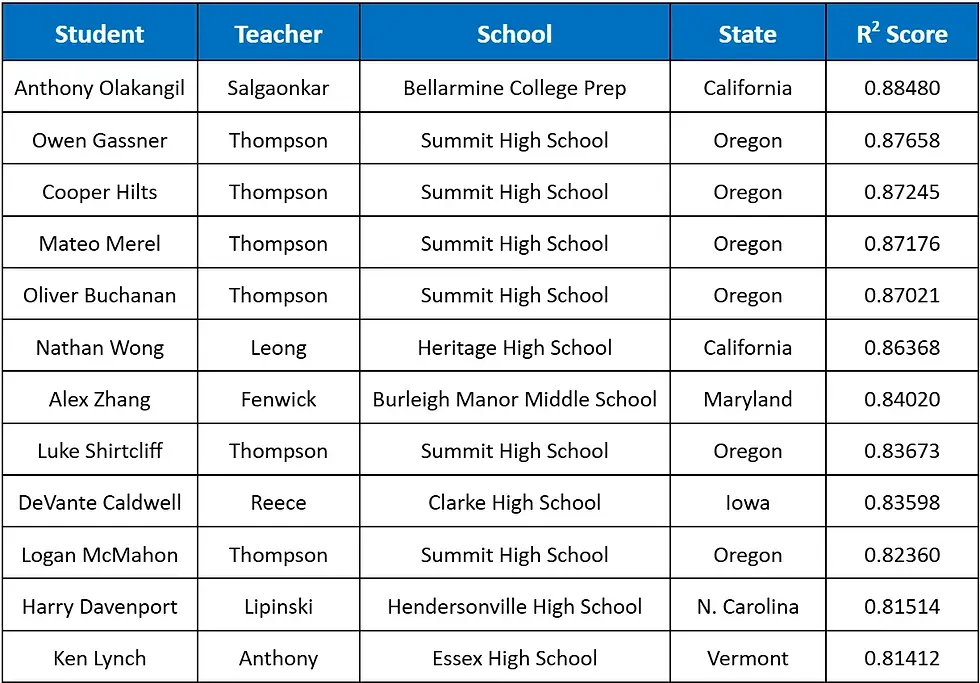2025 Data Science Challenge Champions: After the AP Test, the Big Data Work Begins
- info8292053
- Jul 2, 2025
- 4 min read
What happens when thousands of high school students are given a real-world problem, a national dataset, and no single right answer? They rise to the challenge!
This May, nearly 10,000 students from 436 classrooms and 45 states across the U.S. participated in the third annual After the AP Data Science Challenge, a national competition hosted by Skew the Script, Data Science 4 Everyone, CourseKata, and North Carolina State University’s Data Science and AI Academy.
The challenge invites AP Statistics and AP Computer Science students to put their quantitative skills to the test by building predictive models around a question that’s important to many soon-to-be college students: What factors predict student loan default rates across U.S. colleges? Students win the challenge by submitting models with the highest accuracy (highest R² value) in predicting student loan default rates on a hidden “test” set of colleges.
Using R, Jupyter Notebooks, and real Department of Education data (26 variables from more than 4,400 schools), students analyzed, modeled, and submitted their predictions. Some students walked away with top scores in the challenge. The winners and runners up are listed at the end of this blog post. But, regardless of their place in the standings, every participant gained something even more valuable: a deeper understanding of how data connects to their future.
Rising to the Challenge
Brandon Thompson, an AP Statistics teacher at Summit High School in Oregon who participated in the challenge along with 160 of his students, saw that impact firsthand.
“Most of my students did not have any prior programming experience, and at first many of them struggled with the precision of the coding, but the Notebooks are written in a way where the learning is effectively scaffolded and they learned to persevere as they learned the nuance of coding. By the end, nearly all of my students were proficient and would say things like, ‘I never knew I could code.’”
Six of Thompson’s students placed in the national Top 12. But what stood out to him most was the collaboration.
“Though they were competing amongst each other for that elusive high R² value, they shared strategies with each other without sharing the specific code they used. The collaboration was fun to witness.”

At the top of this year’s leaderboard was Anthony Olakangil, a rising junior at Bellarmine College Preparatory in California. His model achieved an impressive R² value of 0.8848 when predicting student loan default rates on the hidden “test” set of colleges.
But Anthony’s path to the top wasn’t easy. After spending 48 hours trying to brute-force every possible variable combination, he hit a wall, but that failure quickly transformed into a turning point. Anthony soon stepped back, tested new transformations, engineered interaction terms, and wrote a custom trimming function to avoid overfitting his model.
“Initially, I thought data science and statistics were boring: abstract math and visualizations,” Anthony said. “Over time, however, I became more conscious that numbers don’t speak for themselves. Knowing the context behind each variable helped me ask better questions and interpret results more responsibly.”
Anthony’s experience highlights what makes this challenge unique: it pushes students not just to get the 'right' answer, but to think deeply about what the data is actually telling them and how that insight can be shaped by the questions they ask.
A Path Forward
The After the AP Challenge gives students a rare opportunity to work with real-world data and wrestle with complex, open-ended questions. While college affordability is often reduced to national headlines, this challenge encourages students to go deeper, to investigate the patterns and predictors that shape student outcomes, and to think critically about what data can and cannot explain. The experience of digging deeper into the important issue of college debt - using real data science skills - inspired many students to think about pursuing data science in their future studies and careers.
For Ken Lynch, a student from Essex High School in Vermont who placed in the top 12, the experience revealed an unexpected connection between two academic paths. “This challenge has opened my eyes to pursuing something in the computation/data science realm, and I look forward to the many further applications of this in my career."
Owen Gassner, the second-place winner and one of Brandon Thompson’s students at Summit High School in Oregon, echoed that sense of discovery: “Competing in the After the AP Data Science Challenge made me realize how math and statistics can combine with computer programming. The combination of two of my favorite subjects has excited me to explore data science further.”
The Challenge Champions
Congratulations to all students who persevered after a long school year and AP testing season to take part in this year’s challenge! The competition was fierce, and we were so impressed by all the submissions. Most importantly, we were impressed by the learning and discovery that participants demonstrated along the way. We can’t wait to see how you bring these skills to your future studies and work in the years to come!
Without further ado, check out the Top 12 student model submissions, the runners up, and all of their R² scores below! Note: Student model submissions were ranked according to their accuracy (R² scores) in predicting student loan default rates on a hidden “test” set of colleges.
Top 12 Winners

Runners Up
We’d also like to congratulate the runners up of the challenge, who submitted highly predictive and accurate models for the same task, just barely missing the leaderboard:
Raghav Gupta, Mission San Jose High School
Brian Wang, Hunter College High School
Benjamin Seguin, Menomonie High School
Jerome Brown, Baltimore Polytechnic Institute
Rohan Reddy, Mission San Jose High School
Tarini Sajja, Mission San Jose High School
Fan Lin, Baltimore Polytechnic Institute
Sean Miao, Huron High School
.jpg)